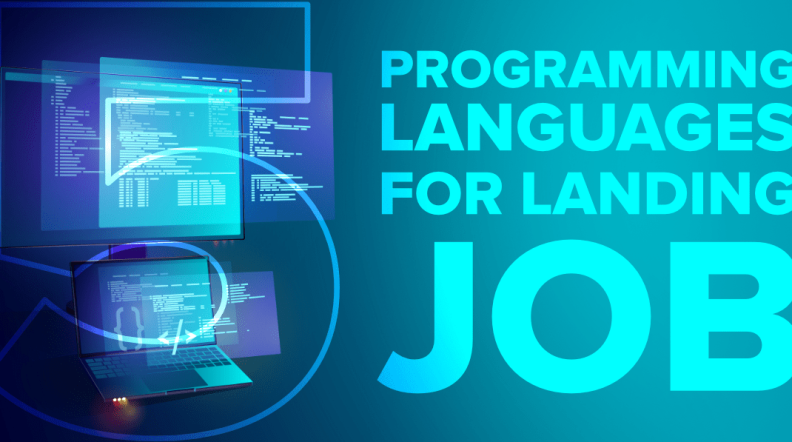Best Programming Language to Get a Job: A Comprehensive Guide






Choosing the best programming languages to learn in 2024 can significantly impact your career prospects. With technology evolving rapidly, languages like Python for data science and AI, JavaScript for frontend development, and Java for android app development remain highly relevant. Companies often seek candidates proficient in specific languages such as Ruby on Rails for web applications, or C and C++ for developing video games and operating systems on devices like the Raspberry Pi. Understanding computer science fundamentals, functional programming concepts, and preparing for common interview questions in these languages can greatly enhance your appeal to potential employers.
Furthermore, the demand for programming skills extends beyond traditional applications. The rise of IoT devices and the continuous growth of the tech industry mean that languages like Python and JavaScript are not just for web or software development but are also key in pioneering fields such as machine learning and network security. As such, aligning your programming skills with the needs of the job market, including mastering languages critical for frontend development and backend systems, can open up numerous job opportunities.
Lastly, it’s not just about the languages you learn but how you apply them. Building a portfolio of projects, contributing to open-source communities, and staying updated with the latest programming trends and technologies are crucial steps. Whether it’s developing mobile apps, creating dynamic web pages with HTML and CSS, or engineering complex backend systems, the ability to showcase your skills through real-world applications can significantly influence your job search success.
Understanding the Job Market for Programmers
The job market for programmers is dynamic and highly sought after. Employers are on the lookout for individuals who not only possess technical skills in various programming languages but also have the ability to adapt to evolving technology landscapes. Recognizing the languages that are in demand and aligning your skill set accordingly can be a decisive factor in securing a lucrative programming job.
Factors Influencing Hiring Decisions
Employers consider a multitude of factors when making hiring decisions for programming roles. These include technical proficiency, problem-solving abilities, and the candidate’s potential to grow within the company. Understanding these factors can help aspiring programmers tailor their learning and professional development efforts towards meeting the industry’s needs.
Job Role and Industry
Data scientists, for instance, are increasingly in demand across various industries due to their ability to analyze and derive meaningful insights from large datasets. This role typically requires proficiency in programming languages such as Python or R, alongside a strong foundation in statistical analysis and machine learning techniques.
Company and Project Requirements
Companies often have specific requirements for programming roles based on the nature of their projects. For example, a tech startup focusing on mobile app development might prioritize candidates skilled in Swift or Kotlin, while a financial institution could favor applicants with strong Java or C# backgrounds for developing secure transaction systems.
Location and Language Popularity
The demand for programming skills can also vary significantly by location. In tech hubs like Silicon Valley, there might be a greater emphasis on languages suited for developing cutting-edge technologies, whereas other regions might have higher demand for languages associated with manufacturing or enterprise systems. Keeping an eye on job opportunities in your desired location can guide your language learning priorities.
The Dynamics of the Job Market
The job market for programmers is highly competitive and constantly evolving. Skills that are highly sought after today may change as new technologies emerge. Staying informed about industry trends and continuously updating your skill set are crucial steps for anyone looking to secure a position in this dynamic field.
Salary, Demand, and Career Goals
Understanding the intersection of salary, demand, and career goals is vital for programmers navigating the job market. Fields like data science and machine learning offer lucrative salaries due to the high demand for these skills. Setting clear career goals and pursuing relevant programming skills can significantly impact your career trajectory and earning potential.
Top Programming Languages for Career Success
For those setting career goals in the tech industry, receiving career advice on the most in-demand programming languages is invaluable. Languages like Python, JavaScript, and Java are essential for a wide range of applications, from mobile apps to desktop applications. Understanding computer programming fundamentals, mastering languages like HTML and CSS for web development, and grasping concepts in object-oriented and general-purpose programming languages can greatly enhance your marketability. Additionally, earning a degree in computer science can provide a solid foundation, but self-study and practical experience are equally important for achieving an attractive average salary.
1. Python – The Gateway to Data Science and AI
As a high-level programming language, Python stands out for its ease of learning and versatility, making it a top choice for roles like python developer and data analyst. Its simple syntax and powerful libraries for data manipulation and analysis have solidified its position as the leading language for aspiring data scientists and those interested in AI development.
2. JavaScript – Essential for Web Development
JavaScript’s role in web development cannot be overstated. As a versatile language, it is critical for both frontend and backend development, making any JavaScript developer a valuable asset. Its compatibility with Linux and ability to be used in network applications further highlight its indispensability. Moreover, its presence in surveys like Stack Overflow attests to its popularity and utility in creating dynamic and interactive web experiences.
3. Java – The Cornerstone for Enterprise Environments
Java developers find their skills in high demand, especially in enterprise environments where Java’s stability and scalability are prized. As an open-source programming language, Java offers a wealth of resources for developers, including libraries and frameworks that are essential for building robust, secure applications. Its use in game development further underscores its versatility and broad applicability.
4. Swift – Leading the Way in Mobile App Development
For developing applications for iPhone and iPad, Swift is the go-to programming language. Its modern syntax and performance optimizations make it ideal for creating fast, reliable mobile applications. Swift’s focus on safety and its comprehensive standard library facilitate the development of complex apps with less code.
5. C and C++ – The Foundation for System Programming
Software developers use C and C++ to communicate directly with hardware, making these languages fundamental for system programming. They allow for writing efficient lines of code that can power everything from operating systems to mobile applications. Their wide use across a variety of programming languages further attests to their versatility and importance in the tech ecosystem.
6. SQL – The Language of Databases
SQL stands as the universal language for interacting with databases, making it an essential skill for software developers looking to manage and analyze data effectively. Its ability to work across a variety of programming languages and platforms makes it a versatile tool in a developer’s arsenal. Understanding SQL can open up diverse career paths in data management and analysis.
7. Go – The Modern Choice for System Networking
Go, also known as Golang, has swiftly become a preferred language for developers working on system networking projects. Its simplicity, alongside powerful concurrency support, makes it ideal for modern network applications and services. Companies value Go for its efficiency and scalability, which are crucial for handling large-scale network tasks. As the digital world continues to evolve, the demand for Go developers is on the rise, making it a lucrative skill for those interested in system networking.
Picking the Right Language for Your Career Path
Choosing the right programming language is crucial for aligning with your career goals. Whether you aspire to develop mobile applications, create robust web platforms, or dive into the world of data science, the language you master can open specific doors in the tech industry. Understanding the market demand, potential salary, and your personal interests will guide you in making an informed decision that best suits your career aspirations.
Web Development and Frontend Languages
For those interested in building visually appealing and functional websites, mastering web development and frontend languages is essential. JavaScript stands out as a cornerstone for web development, enabling the creation of dynamic and interactive web pages. With the rise of mobile applications, frameworks like React Native allow JavaScript developers to bridge the gap between web and mobile app development, offering a versatile skill set in the digital realm.
Choosing Between JavaScript and TypeScript
When it comes to web development, the choice between JavaScript and TypeScript is a common dilemma. JavaScript, with its flexibility and widespread use, is a fundamental skill for any web developer. TypeScript, a superset of JavaScript, offers type safety and is favored for large-scale projects due to its ability to catch errors early. Your choice should consider the project’s requirements, team preferences, and your comfort with strict typing disciplines.
Backend Development Languages for Robust Systems
For developers aiming to build the backbone of applications, mastering backend development languages is key to a successful career in software development. Languages like Python and Java have long been the go-to for creating robust systems. However, the choice of language often depends on the application’s specific needs, scalability requirements, and the developer’s expertise in the language.
The Rise of Go and Elixir in Backend Programming
The backend development landscape is witnessing a shift with the rise of Go and Elixir. Go, known for its efficiency and concurrency model, is becoming a favorite for building high-performance web services. Elixir, leveraging the Erlang VM, is prized for its fault tolerance and hot swapping capabilities, making it ideal for real-time applications. Both languages offer unique advantages for modern backend architectures, catering to the growing demand for scalable and reliable systems.
Mobile App Development: Swift vs Kotlin
In the realm of mobile app development, the choice between Swift and Kotlin often comes down to the platform. Swift is the leading language for developing applications for iPhone and iPad, offering a rich ecosystem and seamless integration with Apple’s hardware. Kotlin, on the other hand, has gained popularity for Android app development, praised for its concise syntax and interoperability with Java. Both languages are modern, designed with safety and performance in mind, making them excellent choices for mobile developers.
Data Science and AI: Why Python Leads the Way
Python reigns supreme in the domains of data science and AI, thanks to its simplicity as a high-level programming language and the vast array of libraries written in Python. Whether you’re aspiring to become a python developer or a data analyst, Python’s readability and extensive support for data manipulation and analysis make it an unparalleled choice. Its dominance is further solidified by frameworks and libraries tailored for AI and machine learning, making Python a gateway to cutting-edge technological advancements.
Enhancing Your Skills: Tools, Ecosystems, and Learning Resources
For programmers, enhancing skills goes beyond mastering a single language. It’s about understanding the ecosystems and tools that complement the language. Whether you’re focusing on web development, mobile app creation, or data science, access to the right tools and resources can significantly boost your proficiency and productivity. In today’s tech landscape, a language is essential, but the ability to navigate its ecosystem is what sets apart successful developers.
Navigating Learning Curves and Ecosystems
Every programming language comes with its own set of challenges and learning curves. For beginners and experienced developers alike, navigating these aspects is crucial for mastering a language. Essential to this journey is understanding that a language is essential not just for its syntax, but for the ecosystem that surrounds it. This includes libraries, frameworks, and community support, which collectively enhance a developer’s ability to build effective solutions.
Online Courses and Technical Bootcamps
Online courses and technical bootcamps offer structured paths for learning programming languages, from the basics of the C programming language to advanced concepts in data analytics. These resources cater to varying skill levels, providing beginner programmers with a solid foundation and enabling experienced developers to specialize further. Whether you’re looking to master a powerful language like Python for data science or a versatile scripting language for web development, these learning platforms can be invaluable in achieving your career goals.
Community Support and Development Tools
The journey in application development and software engineering is significantly smoothed by community support and development tools. Online forums, open-source projects, and developer conferences provide platforms for collaboration, knowledge sharing, and networking. Additionally, integrated development environments (IDEs) and other tools streamline the coding process, allowing developers to focus more on solving problems and less on the intricacies of the language. These resources are pivotal for anyone looking to advance in the tech industry.
The Importance of Scalability and Performance
When choosing a programming language, it’s crucial to consider how well it can handle growing demands. Scalability ensures a system can expand without losing quality. Performance, on the other hand, relates to how fast and efficiently a program runs. Languages ideal for creating robust systems, like Go or Java, offer both. They allow developers to build software that not only meets current needs but can also adapt to future demands, making them highly sought after by tech companies.
Crafting a Strategic Learning Plan to Secure Your Dream Job
To land a dream developer job, a strategic learning plan is essential. This means not just learning to code, but understanding what skills are in demand. Whether aiming for a front-end developer position or aspiring to become a data scientist, aligning your learning with market needs is key. Coding bootcamps and a degree in computer science can provide a solid foundation, but they should be part of a larger plan that includes hands-on projects and continuous skill upgrades.
Setting Clear Career Goals
Setting clear career goals is the first step toward a successful programming career. Whether your interest lies in mobile app development or you dream of becoming a database administrator, knowing what you want to achieve helps tailor your learning journey. It guides your decisions on which programming languages to focus on and what additional skills you might need. This clarity ensures your efforts are directed towards roles that match your aspirations.
Aligning Language Learning with Industry Demands
In today’s rapidly changing tech landscape, aligning language learning with industry demands is crucial. For those eyeing a career in web development, mastering JavaScript is essential. Similarly, Python remains the language for creating cutting-edge data science and AI applications. Understanding these trends helps learners focus their efforts on skills that are not only in demand but also offer a pathway to fulfilling and lucrative careers. Staying informed about the needs of the industry ensures relevance and competitiveness in the job market.
Continuous Learning and Project Portfolio Development
Continuous learning and developing a project portfolio go hand in hand in securing a programming job. As technology evolves, so do the skills required to stay ahead. Engaging in real-world projects allows learners to apply their knowledge, tackle practical challenges, and showcase their abilities to potential employers. This combination of ongoing education and hands-on experience is key to building a career that grows with the industry.
Leveraging Practice and Real-World Applications
Leveraging practice through real-world applications is vital for aspiring programmers. It bridges the gap between theoretical knowledge and practical skills. By working on projects that solve actual problems, learners gain experience that is highly valued by employers. This approach not only enhances coding skills but also fosters problem-solving and critical thinking, preparing individuals for the challenges of a developer job.
Conclusion: Your Journey Towards a Successful Programming Career Begins
Your journey towards a successful programming career is shaped by continuous learning, adaptability, and a strategic approach to skill development. By setting clear career goals, aligning your learning with industry demands, and leveraging real-world applications, you pave the way for a rewarding future. Remember, the tech industry is ever-evolving, and staying ahead means embracing change, seeking out new learning opportunities, and being prepared to adapt your skills and knowledge to meet the challenges ahead.
Embracing Change and Staying Ahead in the Tech Industry
Staying ahead in the tech industry requires embracing change. With tech companies constantly innovating, programming languages in 2023 might differ from those in demand a few years down the line. High-level languages, object-oriented language concepts, and server-side scripting are among the in-demand skills today. Keeping abreast of these changes, supported by Microsoft backing and community engagement in core languages, ensures developers remain competitive and can navigate the tech landscape confidently.
The Role of Continuous Learning and Adaptation
The role of continuous learning and adaptation cannot be overstated in the tech industry. As new programming languages emerge and existing ones evolve, developers must commit to lifelong learning. This not only involves mastering high-level languages and understanding low-level language principles but also exploring new domains like unity game development. By constantly updating their skills, developers can seize new opportunities, tackle emerging challenges, and ensure their relevance in a dynamic and competitive field.